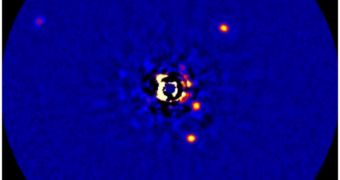The international astronomical community is current in doubts whether a recently-found extrasolar planet actually exists, or whether it is simply a fluke in long-term calculations. If the body is indeed real, then many of our theories on how planets form around stars may need revising.
The peculiar object was discovered orbiting around the bright and very young alien star called HR 8799, which is known to harbor three other exoplanets as well.
Until now, astronomers thought that they understood the fairly nearby system pretty good. The parent star lies no more than 120 light-years away from Earth, which basically means it's in our backyard, in astronomical terms.
The three exoplanets that were known to exist around HR8799 were also the targets of the first study that managed to obtain direct images of worlds orbiting another star.
But the newly-found member of the family is reportedly heavier than all three of them, weighing in at around seven Jupiter masses, or just over 2224 Earth masses.
The body lies an estimated 14.5 astronomical units (AU) away from its parent star, which means that it can be found 14.5 times farther away than our planet is from the Sun.
Using the W.M. Keck Observatory in Hawaii, astronomers conducted observations of the exoplanet for about 15 months, in an attempt to make sure that the celestial object is actually there, Space reports.
What is remarkable in the new configuration of the HR 8799 star system is that the three established exoplanets orbit their parent at around 25, 40 and 70 AU, respectively, whereas the newly-found planet is very close by comparison.
Additionally, there are currently no models of exoplanetary formation that can explain how that star system developed in its current configuration. By all accounts, the innermost planet shouldn't exist.
In a paper published before print in the December 8 issue of the esteemed journal Nature, experts propose an explanation for this seemingly mysterious situation.
They say that the protoplanetary disk around HR 8799 is so massive, that it's basically capable of dragging planets around, an ability that it most likely had since the star first appeared.
This may explain exoplanets that formed around gravitational instabilities (a common model for planetary formation) can be found in the inner solar system, while those formed through core accretion are at the edges of it.
“We still need to run the simulations to see if that can explain the current system. It is not obvious that you can drag four massive planets for tens of AUs and keep the system from ejecting a planet or two in the process,” says Christian Marois.
The researcher holds an appointment as an astronomer at the National Research Council of Canada. “We now hope to look more at HR 8799 to see if we can find another planet,” he adds.
“We also hope to do more detailed observations on the planets to figure out more about their atmospheres, physics and chemistry,” the expert goes on to say.
“Data on another planet and more data about the planets could give hints about how they all formed, and maybe shed light on any global laws for how planets form,” Marois concludes.

 14 DAY TRIAL //
14 DAY TRIAL //